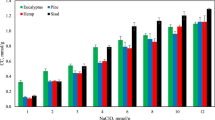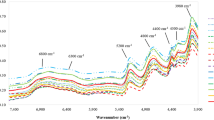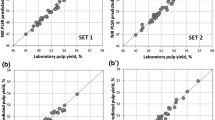Abstract
Bioethanol can be obtained from wood by simultaneous enzymatic saccharification and fermentation step (SSF). However, for enzymatic process to be effective, a pretreatment is needed to break the wood structure and to remove lignin to expose the carbohydrates components. Evaluation of these processes requires characterization of the materials generated in the different stages. The traditional analytical methods of wood, pretreated materials (pulps), monosaccharides in the hydrolyzated pulps, and ethanol involve laborious and destructive methodologies. This, together with the high cost of enzymes and the possibility to obtain low ethanol yields from some pulps, makes it suitable to have rapid, nondestructive, less expensive, and quantitative methods to monitoring the processes to obtain ethanol from wood. In this work, infrared spectroscopy (IR) accompanied with multivariate analysis is used to characterize chemically organosolv pretreated Eucalyptus globulus pulps (glucans, lignin, and hemicellulosic sugars), as well as to predict the ethanol yield after a SSF process. Mid (4,000–400 cm−1) and near-infrared (12,500–4,000 cm−1) spectra of pulps were used in order to obtain calibration models through of partial least squares regression (PLS). The obtained multivariate models were validated by cross validation and by external validation. Mid-infrared (mid-IR)/NIR PLS models to quantify ethanol concentration were also compared with a mathematical approach to predict ethanol yield estimated from the chemical composition of the pulps determined by wet chemical methods (discrete chemical data). Results show the high ability of the infrared spectra in both regions, mid-IR and NIR, to calibrate and predict the ethanol yield and the chemical components of pulps, with low values of standard calibration and validation errors (root mean square error of calibration, root mean square error of validation (RMSEV), and root mean square error of prediction), high correlation between predicted and measured by the reference methods values (R 2 between 0.789 and 0.997), and adequate values of the ratio between the standard deviation of the reference methods and the standard errors of infrared PLS models relative performance determinant (RPD) (greater than 3 for majority of the models). Use of IR for ethanol quantification showed similar and even better results to the obtained with the discrete chemical data, especially in the case of mid-IR models, where ethanol concentration can be estimated with a RMSEV equal to 1.9 g L−1. These results could facilitate the analysis of high number of samples required in the evaluation and optimization of the processes.






Similar content being viewed by others
References
Araque, E., Parra, C., Freer, J., Contreras, D., Rodriguez, J., Mendonca, R., & Baeza, J. (2008). Enzyme and Microbial Technology, 43, 214–219.
Wyman, C. E. (Ed.). (1996). Handbook on bioethanol. Boca Raton: CRC.
Lora, J. H., & Glasser, W. G. (2002). Journal of Polymers and the Environment, 10, 39–48.
Lora, J. C. A., Wu, L. C. F and Goyal, G. (1991). Proceedings of the 6th International Symposium on Wood and Pulping Chemistry, 431–438
Díaz, M. J., Alfaro, A., García, M. M., Eugenio, M. E., Ariza, J., & López, F. (2004). Industrial and Engineering Chemistry Research, 43, 1875–1881.
Gilarrahz, M. A., Oliet, M., Rodriguez, F., & Tijero, J. (1998). Canadian Journal of Chemical Engineering, 76, 253–260.
Jiménez, L., Pérez, I., García, J. C., López, F., & Ariza, J. (2004). Wood Science and Technology, 38, 127–137.
Pan, X., Xie, D., Kang, K. Y., Yoon, S. L., & Saddler, J. N. (2007). Applied Biochemistry and Biotechnology, 137, 367–377.
Sassner, P., Galbe, M., & Zacchi, G. (2006). Enzyme and Microbial Technology, 39, 756–762.
Söderström, J., Pilcher, L., Galbe, M., & Zacchi, G. (2003). Biomass and Bioenergy, 24, 475–486.
Wingren, A., Galbe, M., & Zacchi, G. (2003). Biotechnology Progress, 19, 1109–1117.
Zhu, J. Y., Pan, X. J., & Zalesny, R. S. (2010). Applied Microbiology and Biotechnology, 87, 847–857.
Puls, J., Poutanen, K., Körner, H. U., & Viikari, L. (1985). Applied Microbiology and Biotechnology, 22, 416–423.
National Renewable Energy Laboratory. (2008) Technical report NREL/TP-510-42630. USA.
Gong, Y. M., & Zhang, W. (2008). Spectroscopy and Spectral Analysis, 28, 1544–1548.
Tsuchikawa, S. (2007). Applied Spectroscopy Reviews, 42, 43–71.
Ye, X. P., Liu, L., Hayes, D., Womac, A., Hong, K. L., & Sokhansanj, S. (2008). Bioresource Technology, 99, 7323–7332.
Liu, L., Ye, X. P., Womac, A. R., & Sokhansanj, S. (2010). Carbohydrate Polymers, 81, 820–829.
Lindedam, J., Bruun, S., DeMartini, J., Rgensen, H., Felby, C., Yang, B., Wyman, C. E., & Magid, J. (2010). Journal Biobased Materials Bioenergy, 4, 378–383.
Krongtaew, C., Messner, K., Ters, T., & Fackler, K. (2010). Bioresources, 5, 2063–2080.
Horikawa, Y., Takada, R., Watanabe, T., Takabe, K., Kobayashi, Y., & Sugiyama, J. (2011). Applied Biochemistry and Biotechnology, 164, 194–203.
Shen Hou, L. L. (2010). Journal of Integrative Plant Biology, 53, 166–175.
Workman, J. J., & Weyer, L. (2007). Practical guide to interpretative near-infrared spectroscopy (p. 332). Boca Ratón: CRC.
Hein, P. R. G., Clair, B., Brancheriau, L., & Chaix, G. (2010). Journal of Near Infrared Spectroscopy, 18, 455–464.
Hein, P. R. G., Brancheriau, L., Trugilho, P. F., Lima, J. T., & Chaix, G. (2010). Journal of Near Infrared Spectroscopy, 18, 443–454.
El Hage, R., Brosse, N., Chrusciel, L., Sanchez, C., Sannigrahi, P., & Ragauskas, A. (2009). Polymer Degradation and Stability, 94, 1632–1638.
Li, M. F., Fan, Y. M., Xu, F., Sun, R. C., & Zhang, X. L. (2010). Industrial Crops and Products, 32, 551–559.
Vazquez, G., Gonzalez, J., Freire, S., & Antorrena, G. (2002). Holz Als Roh-Und Werkstoff, 60, 25–30.
Sjöström, E. (1993). Wood chemistry: fundamentals and applications (2nd ed.). USA: Academic.
Williams, P. C. (2001). Implementation of near-infrared technology. In P. N. K. Williams (Ed.), Near-infrared technology in the agricultural and food industries (2nd ed.). St. Paul Minnesota: American Association of Cereal Chemists, Inc.
Terdwongworakul, A., Punsuwan, V., Thanapase, W., & Tsuchikawa, S. (2005). Journal of Wood Science, 51, 167–171.
Bruun, S., Jensen, J. W., Magid, J., Lindedam, J., & Engelsen, S. B. (2010). Industrial Crops and Products, 31, 321–326.
Wang, K., Jiang, J. X., Xu, F., & Sun, R. C. (2009). Polymer Degradation and Stability, 94, 1379–1388.
Acknowledgments
Authors thank the financial support by Fondecyt Postdoctoral 3100078 and Fondecyt 1110819 projects (Fondecyt, Chile). This is a contribution in memoriam to Prof. Dr. Jaime Baeza, who participated actively in the development of this work and was a great driving for the research about bioethanol in Chile and the region.
Author information
Authors and Affiliations
Corresponding author
Rights and permissions
About this article
Cite this article
Castillo, R.d.P., Baeza, J., Rubilar, J. et al. Infrared Spectroscopy as Alternative to Wet Chemical Analysis to Characterize Eucalyptus globulus Pulps and Predict Their Ethanol Yield for a Simultaneous Saccharification and Fermentation Process. Appl Biochem Biotechnol 168, 2028–2042 (2012). https://doi.org/10.1007/s12010-012-9915-1
Received:
Accepted:
Published:
Issue Date:
DOI: https://doi.org/10.1007/s12010-012-9915-1




